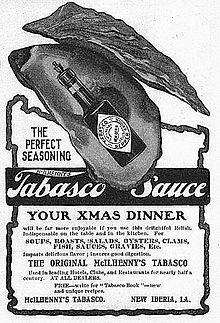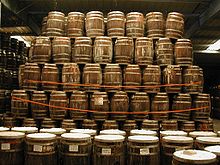Tabasco Factory Makes
How the Tabasco Factory Makes 700,000 Bottles of Per Day
Tabasco is an American brand of hot sauce made from vinegar, tabasco peppers (Capsicum frutescens var. tabasco), and salt. It is produced by McIlhenny Company of Avery Island in south Louisiana, having been created over 150 years ago by Edmund McIlhenny.[1]
Although tabasco peppers were initially grown only on Avery Island, they are now primarily cultivated in Central America, South America and Africa.[2] The Tabasco sauce brand also has multiple varieties including the original red sauce, habanero, chipotle, sriracha and Trinidad Moruga scorpion. Tabasco products are available in more than 195 countries and territories, and packaged in 36 languages and dialects.
History[edit]
According to the company's official history, Tabasco was first produced in 1868 by Edmund McIlhenny,[3] a Maryland-born former banker who moved to Louisiana around 1840.
However, as Jeffrey Rothfeder's book McIlhenny's Gold points out, some of the McIlhenny Company's official history is disputed, and that the politician Maunsel White was producing a tabasco pepper sauce two decades before McIlhenny.[4] A 2007 book review by Mark Robichaux of The Wall Street Journal quotes Rothfeder's book:
Rothfeder cited January 26, 1850, letter to the New Orleans Daily Delta newspaper crediting White as having introduced "Tobasco red pepper" (sic) to the southern United States and asserting that the McIlhenny was at least inspired by White's recipe.[4] Jean Andrews, in her book "Peppers: The Domesticated Capsicums", goes further to declare—citing United States Circuit Court testimony from 1922—that prior to his death in 1862, "White gave some [pepper] pods, along with his recipe, to his friend Edmund McIlhenny, during a visit to White's Deer Range Plantation."[5]
To distribute his, Edmund McIlhenny initially obtained unused cologne bottles from a New Orleans glass supplier. On his death in 1890, McIlhenny was succeeded by his eldest son, John Avery McIlhenny, who expanded and modernized the business, but resigned after only a few years in order to join Theodore Roosevelt's 1st US Volunteer Cavalry Regiment, the Rough Riders.[6] On John's departure, brother Edward Avery McIlhenny, a self-taught naturalist fresh from an Arctic adventure, assumed control of the company and also focused on expansion and modernization, running the business from 1898 until his death in 1949.
Walter S. McIlhenny in turn succeeded his uncle Edward Avery McIlhenny, serving as president of McIlhenny Company from 1949 until his death in 1985. Edward McIlhenny Simmons then ran the company as president and CEO for several years, remaining as board chairman until his death in 2012.[7] Paul McIlhenny became company president in 1998 and was chairman until his death in 2013.[8] In 2012 McIlhenny cousin Tony Simmons assumed the company's presidency and in June 2019 his cousin Harold Osborn was chosen as the next president and CEO.[9][10]
McIlhenny was one of just a few U.S. companies to have received a royal warrant of appointment that certified the company as a supplier to Queen Elizabeth II. McIlhenny was one of the 850 companies around the world that have been officially designated as suppliers to the queen by such warrants. The warrant held was "Supplier of Tabasco HM The Queen — Master of the Household — Granted in 2009".[11]
In 2005, Avery Island was hit hard by Hurricane Rita, and the family constructed a 17-foot (5.2 m)-high levee around the low side of the factory and invested in back-up generators.[12]
Production[edit]
Originally all peppers used in Tabasco sauce were grown on Avery Island. Over time growers were selected throughout Louisiana to accommodate demand and during the 1960's the company established farms in various Latin American countries. As of 2013 peppers grown on the Island are used to produce seed stock, which is then shipped to foreign growers.[12] More predictable weather and readily available farmland in these locales allow a constant year-round supply. This ensures the availability of peppers should severe weather or other problems occur at a particular growing location.
Following company tradition, peppers are picked by hand. To ensure ripeness, pickers compare peppers to a little red stick (le petit bâton rouge); peppers that match the color of the stick are then introduced into the sauce production process. Peppers are ground into a mash on the day of harvest and placed along with salt in white oak barrels previously used for whiskey of various distilleries.[13] To prepare the barrel, the inside of the barrel is de-charred (top layer of wood is removed), torched, and cleaned, to minimize the presence of any residual whiskey. The barrels are then used in warehouses on Avery Island for aging the mash.
After aging for up to three years, the mash is strained to remove skins and seeds. The resulting liquid is then mixed with distilled vinegar, stirred occasionally for a month, and then bottled as a finished sauce.[14] Tabasco has released a Tabasco reserve edition with peppers aged for up to eight years, mixed with wine vinegar.[15]
Tabasco Diamond Reserve Edition was a limited bottling released in 2018 to commemorate the brand's 150th anniversary. This sauce consists of peppers that have been aged for up to fifteen years, then mixed with sparkling white wine vinegar.[16]
For many years the salt used in Tabasco production came from the Avery Island salt dome, the largest such structure along the Louisiana coast.[17]


Comments
Post a Comment
Thank you.